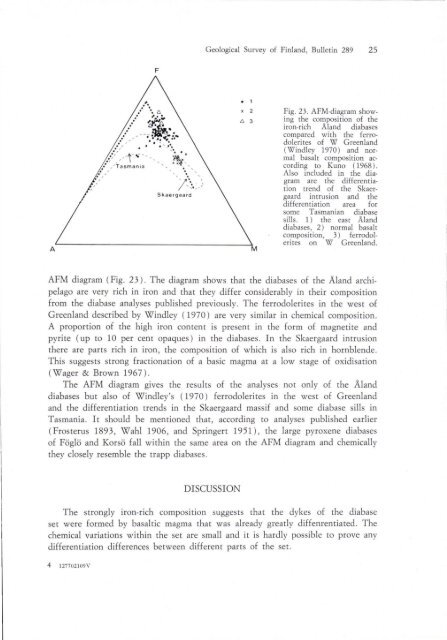Geological Survey of Finland Bulletin 289 - arkisto.gsf.fi
Geological Survey of Finland Bulletin 289 - arkisto.gsf.fi
Geological Survey of Finland Bulletin 289 - arkisto.gsf.fi
You also want an ePaper? Increase the reach of your titles
YUMPU automatically turns print PDFs into web optimized ePapers that Google loves.
A<br />
F<br />
<strong>Geological</strong> <strong>Survey</strong> <strong>of</strong> <strong>Finland</strong>, <strong>Bulletin</strong> <strong>289</strong> 25<br />
M<br />
Fig. 23. AFM-diagram showing<br />
the composition <strong>of</strong> the<br />
iron-rich Aland diabases<br />
compared with the ferrodolerites<br />
<strong>of</strong> W Greenland<br />
(Windley 1970) and normal<br />
basalt composition according<br />
to Kuno (1968).<br />
Also included in the diagram<br />
are the differentiation<br />
trend <strong>of</strong> the Skaergaard<br />
intrusion and the<br />
differentiation area for<br />
some Tasmanian diabase<br />
sills. 1 ) the eas t Aland<br />
diabases, 2) normal basalt<br />
composition, 3) ferrodolerites<br />
on W Greenland.<br />
AFM diagram (Fig. 23). The diagram shows that the diabases <strong>of</strong> the Aland archipelago<br />
are very rich in iron and that they differ considerably in their composition<br />
from the diabase analyses published previously. The ferrodolerites in the west <strong>of</strong><br />
Greenland described by Windley (1970) are very similar in chemical composition.<br />
A proportion <strong>of</strong> the high iron content is present in the form <strong>of</strong> magnetite and<br />
pyrite (up to 10 per cent opaques) in the diabases. In the Skaergaard intrusion<br />
there are parts rich in iron, the composition <strong>of</strong> which is also rich in hornblende.<br />
This suggests strong fractionation <strong>of</strong> a basic magma at a low stage oE oxidisation<br />
(Wager & Brown 1967).<br />
The AFM diagram gives the results oE the analyses not only <strong>of</strong> the Aland<br />
diabases but also oE Windley's (1970) Eerrodolerites in the west <strong>of</strong> Greenland<br />
and the differentiation trends in the Skaergaard massif and so me diabase sills in<br />
Tasmania. It should be mentioned that, according to analyses published earlier<br />
(Frosterus 1893, Wahl 1906, and Springert 1951), the large pyroxene diabases<br />
<strong>of</strong> Föglö and Korsö fall within the same area on the AFM diagram and chemically<br />
they closely resemble the trapp diabases.<br />
DISCUSSION<br />
Thestrongly iron-rich composltlon suggests that the dykes <strong>of</strong> the diabase<br />
set were formed by basaltic magma that was already greatly diffenrentiated. The<br />
chemie al variations within the set are small and it is hardly possible to prove any<br />
differentiation differences between different parts <strong>of</strong> the set.<br />
4 127702109V

















